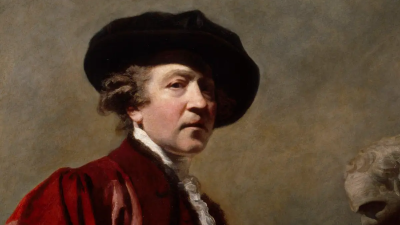
George Frederic Watts RA, Compositional studies for 'Olympus on Ida', 1880s?.
Black chalk on brown wove paper. © Photo: Royal Academy of Arts, London. Photographer: John Hammond.
This image is not available to download. To licence this image for commercial purposes, contact our Picture Library at picturelibrary@royalacademy.org.uk
Compositional studies for 'Olympus on Ida', 1880s?
George Frederic Watts RA (1817 - 1904)
RA Collection: Art
A sheet of compositional sketches for 'Olympus on Ida' (1872-79 version in the Watts Gallery and 1885 Private collection). The three figure groupings along the top of the sheet are very close to the composition of the finished painting while the other three drawings at the bottom concentrate on variations to the pose of the central figure.
Watts painted a number of compositions of three standing goddesses, including the canvas now owned by the Faringdon Trust (1865-72), known variously as 'The Three Goddesses', 'The Three Graces', 'The Judgement of Paris' and 'Pallas, Juno and Venus'. 'Olympus on Ida' is a later variation on a similar theme painted in a less naturalistic style. The composition differs in that the central figure, seen from the back in the earlier works, takes a frontal pose in 'Olympus on Ida', as in these preparatory drawings.
According to Mary Watts, this painting and a number of others from the mid-1860s onwards were associated with one of Watts's favourite models, 'Long Mary', of whom 'he often said that, in the flexibility of movement as well as in the magnificence of line, in his experience she had no equal'. However, Madeline Wyndham served as the model for the face and shoulders for studies carried out in the early 1870s (Watts Gallery, see Franklin Gould catalogue). In a letter to William Moss, who purchased one of the paintings in 1890, Watts wrote 'I have tried to express without attributes the different characteristics of the Goddesses, & by the qualities of surface to suggest a certain sense of the celestial purpose accompanying them' (Franklin Gould).
Further reading:
Mary Seton Watts, George Frederic Watts - The Annals of an Artist's Life, London 1912, Vol II, pp. 44-45
Robert Upstone and Andrew Wilton eds., The Age of Rossetti, Burne-Jones and Watts: Symbolism in Britain 1860-1910 , exhib. cat., London, 1997, catalogue 14,pp. 114-115 and pp. 66 and 72.
Veronica Franklin Gould ed., The Vision of G F Watts, exhib. cat., The Watts Gallery, 2004, cat. nos. 31-32, p. 57
The life drawings in this group depict G. F. Watts's favourite model, Mary Bartley. A housemaid at Little Holland House where Watts lived as a guest of the Prinsep family, she became known as 'Long Mary' because of her great height and was persuaded to model for Watts. Her tall, statuesque figure can be seen in many of his paintings.
Mary Seton Watts, the artist's wife, wrote: 'When painting, Signor [Watts] referred to the studies made in charcoal on brown paper from this most splendid model [Long Mary] - noble in form and in the simplicity and innocence of her nature - a model of whom he often said that, in the flexibility of movement as well as in the magnificence of line, in his experience she had no equal. Many of the studies made from her are now in the possession of the Royal Academy and at the British Museum, while some are preserved in the Sculpture Gallery at Compton. They inspired his work from the first half of the 'sixties to the end of his life. The pictures 'Daphne', 'The Judgement of Paris', 'The Childhood of Zeus' - the Eve trilogy - 'Dawn', 'Olympus on Ida', 'The Wife of Midas', are notable examples of paintings in which he referred to these studies...'.
Long Mary is said to have died in the early 1870s but Watts continued to refer to the drawings he had made of her throughout his career. They formed what he called 'the grammar of the higher language of art'. Although he made many studies of Long Mary and of other models, his general aim in painting was to portray universal figures rather than individuals and he therefore created composite poses from various different drawings and then painted from these and from memory.
Further reading:
Mary Seton Watts, George Frederic Watts:The Annals of an Artist's Life, London, 1912, Vol II, pp. 44-5
Watts often expressed the emotive force of his figures through their pose or drapery rather than by facial expression. This is apparent in the large number of figures depicted from the side or the back in both his paintings and his drawings. This group of drawings in the Royal Academy collection gives some indication of the large number of Watts's figure studies and preparatory drawings which concentrate on the back.
Watts's choice of poses seems to be part of the same impulse as his habit of obscuring the facial features of figures in his allegorical paintings. Both are part of an effort to universalise his subjects rather than focusing on their individual traits. His sometimes unconventional poses also reveal his dislike for relying on generic compositional rules, or what he called 'picture making'.
Further reading:
Veronica Franklin Gould ed., The Vision of G F Watts, exhib. cat., The Watts Gallery, 2004, pp. 72-74
Object details
Start exploring the RA Collection
- Explore art works, paint-smeared palettes, scribbled letters and more...
- Artists and architects have run the RA for 250 years.
Our Collection is a record of them.



